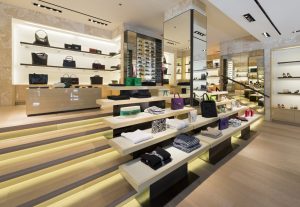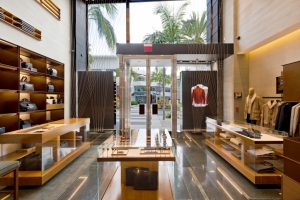Glassdoor is the YouTube of salary websites.
You go to check one teensy little thing and the next thing you know, you’re triangulating individual salaries on position title and the anonymous range. (Guess what one report of a salary between $20,000 and $22,000 works out to be?)
The popular site catalogs job openings, interviewee reviews, companies and – most grippingly – salary by company and even position. Self-reporting is inaccurate at best, but there’s more certainty in numbers. Recently, 97 hourly visual merchandisers at Forever 21 reported an average wage of $12.38.
We want the economy to be booming and it is certainly growing. But the new growth boom of a decade ago has slowed, replaced by tire-kicking stores forced to refresh or redesign after half a decade of stagnancy.
For designers, that means lean-but-growing projects and a job market that’s beginning to forgive a few years of unemployment.
SHOW ME THE MONEY
The Bureau of Labor Statistics, which can always be counted upon to present data in the least sexy way possible, lumps retail designers into the surprisingly specific “merchandise displayers and window trimmers” category, with an average wage of $14.39 hourly and $29,930 annually. Across the various sectors of retail, average wages range from about $30,000-$40,000, just barely over the purported minimum needed for survival in New York.
Advertisement
For mid-level careerists, combine interior design numbers from the BLS (median salary: $47,600) with a peek at Glassdoor, where reports range from $30,000-$350,000, itself a hint at the disparity between entry-level gigs and design vp positions at the industry’s biggest players.
To save you time, we checked a few pseudo-scientific sources for average salaries. Numbers vary widely among Careerbliss (store designer: $48,500), Fashionista (visual merchandiser: $37,100), retailindustry.about.com (visual merchandiser: $34,000-54,000), Salary.com (store design director: $119,989 median) and SimplyHired (retail store designer: $41,000).
Maybe it’s better to ask a few friends.
Take those numbers with a grain – or a tablespoon – of salt. Just know that retail sales and new builds are inching forward, and your salary should be, too. Same-store sales increased an average of 5.4 percent each month in 2012; that became 3.5 percent in 2013 as growth leveled off. (Data sourced by Thomson Reuters I/B/E/S estimates.) Numbers are abysmal for 2014 so far which is “hands down, due to bad weather,” says Jharonne Martis, director of consumer research for Thomson Reuters.
IT’S THE ECONOMY, STUPID
Meanwhile, “In North America, shoppers have returned,” says Jim Scarpone, director, Shawmut Design and Construction (New York). He has good reason to be optimistic; Shawmut was named the largest retail construction firm in 2013 by Building Design + Construction magazine.
Scarpone points to new malls and retailers in Salt Lake City, Washington’s CityCenterDC, the Miami Design District, and the World Trade Center and Brookfield Place in New York, along with expansion plans by fast-fashion giants H&M and Uniqlo, whose leaders plan to open at least 20 new stores in the U.S. this year.
Advertisement
But booming business for these urban centers may not be translating to the country as a whole. David Triompo, managing director of consumer products for Great American Group (Woodland Hills, Calif.), says that in 2013, retail was “a more sustained business. There was very limited growth, in the global sense; between 0 and 4 percent on any given month, versus 2011 and 2012, when there was more of an up and down.”
And when there is new growth, it’s smaller, with an eye to future downsizing. Chuck Taylor, business operations director for Chicago-based Englewood Construction, says his mid-sized firm is seeing smaller new builds and cautious redesigns: “Everybody’s extremely conscious about those remodeling dollars reinvesting back into stores.”
Business may be back, but it’s not yet booming.
OMNI-CHANNEL OVERLOAD
VMSD has bemoaned the overuse of this buzzword, but the Amazon creep continues, with online sales growing to 6 percent of total retail sales in the fourth quarter of 2013; that’s a 16 percent year-over-year change, according to the U.S. Department of Commerce.
And with online retailers creating catchy promotions, like monthly sample boxes from Birchbox or flash sales sites like Woot!, retailers are forced to examine tech-driven perks to compete.
What’s clear is that retailers have begun to pay lip service to omni-channel, a nod to some of the concessions made to the online sector over the past few years. But are they really taking it to heart?
Advertisement
A 2013 Retail Systems Research survey (funded by hybris software) of 98 retailers found that the interest in omni-channel is growing. Three-quarters of respondents rated omni-channel fulfillment as highly important (a 27 percent jump from 2012). Yet they reported struggling to create a seamless customer experience. And customers are mainly buying online and picking-up or returning merchandise in-store, or vice versa – hardly futuristic leaps for today’s shopper.
Many retailers hope experience-driven stores will pull customers back in. They imagine shoppers checking prices online, then heading to stores to test, try and buy. Great American Group’s Triompo finds this speculative: “Who knows how much of that is retail rhetoric?”
He points to Macy’s and Nordstrom as two larger retailers that are competing handily. Macy’s online sales exceeded $2 billion in 2012 thanks to smart use of RFIDs, according to Chain Store Age. Still, he says, “I don’t think anyone’s lighting the world on fire with it. … A lot of this is, ‘How do we compete with the Amazons of the world, who have everything in the world on their site with flat-rate, two-day shipping?’”
SECTOR UPS AND DOWNS
Electronics are hurting. Best Buy dropped out of Chain Store Age’s Top 100 in 2013 for “the first time in years,” edged out by the expected giants – Walmart, Costco, Kroger, Home Depot, Target – and Amazon, which popped up at #8.
Amazon’s net income for 2012 was -$39,000. That’s right; the behemoth is actually losing money.
Yet Amazon’s influence is undeniable. To wit, Walmart president and ceo Neil Ashe told investors last May that e-commerce was the company’s top priority for new growth.
And if anyone can afford to ignore online, it’s this discount behemoth, which topped the Chain Store Age list with $446 million in net sales in 2012 – more than four times the net of Costco, which ranked second.
After enduring years of barbs and jabs as shopping mall anchors dissolved, department stores are poised for growth, according to Great American Group’s quarterly Retail Monitor (March 2014).
Forget about new shopping malls. Department stores are rushing to open bargain-driven off-market chains such as Nordstrom Rack and Saks Off 5th that compete with Marshalls and T.J.Maxx.
The stigma of discount shopping, for most Americans, is gone. It’s been replaced by thicker wallets and a sense of, “Why pay full price?” And, says Thomson Reuters’ Martis, “There’s a huge discrepancy bet low- and high-income shoppers. Low income people are being squeezed by the unemployment rate and they’re getting less from food stamps – they’re sticking to necessities and staples. High-end shoppers are firing on all cylinders.”
Luxury will always be luxury. And here’s the polarizing factor: High-end shoppers want Bergdorf and Bloomie’s, and they’ll pay to keep them open. Everyone else just wants a deal. “We’ve really seen a stratification of the business. The luxury sector, from Neiman Marcus down to Macy’s, has outperformed, whereas the Kohl’s and JCPenneys and Sears have really struggled,” Triompo says.
PUSH TO THE FUTURE
With the pain of the recession fading, investors are starting to question the fate of some struggling retailers and wondering whether changes, like JCPenney’s endless overhauls, will pay off.
“The challenge we’re hearing from our retail clients is that they have to reinvent themselves on size, product and the experience of stores,” Taylor says. And “experience” is certainly the buzzword for 2014.
In the lean, mean years since 2008, retailers have learned how to salvage customer relationships. “In the retail world, when you lose your customer, it’s very challenging to get them back,” says Triompo. “A customer has x dollars to spend and s/he shops in every sector. That customer doesn’t always come back.”
Shoppers are gone, replaced by acquaintances who hang out in stores, sipping and sampling. They’re not consumers waiting to buy but guests to be ushered, escorted, entertained. They need merchandise, but they want expertise – and assurance that in a world exploding with choice, they’re getting a good fit.


 Photo Gallery6 days ago
Photo Gallery6 days ago
 Headlines2 weeks ago
Headlines2 weeks ago
 Headlines6 days ago
Headlines6 days ago
 Headlines1 week ago
Headlines1 week ago
 Headlines2 weeks ago
Headlines2 weeks ago
 Headlines7 days ago
Headlines7 days ago
 Designer Dozen2 weeks ago
Designer Dozen2 weeks ago
 Special Reports2 weeks ago
Special Reports2 weeks ago




















